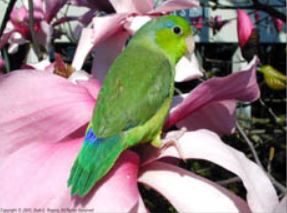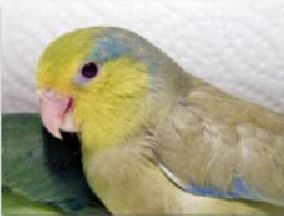Keeping Parrotlets : Mutations, Diet, Personality
Keeping Parrotlets: They are a group of the smallest New World parrot species, comprising several genera, namely Forpus, Nannopsittaca, and Touit. (Wikipedia)
Introduction to keeping Parrotlets
Whoever coined the saying “good things come in small packages” probably had a Parrotlet as a pet. In spite of their diminutive size (around 4 inches long), these little characters have all the personality and character of their larger cousins, the Amazons.
Keeping Parrotlets Species
Hailing from South America, the Forpus family contains seven species of parrotlets. The most common of these in American aviculture is:
- F. coelestis, the Pacific parrotlet, also sometimes known as the celestial parrotlet.
- F. passerinus, the green-rumped parrotlet, is also relatively well-known, followed by
- F. conspicillatus, the spectacled parrotlet.
- F. vividus, the blue-winged parrotlet, (much rarer)
- F. cyanopygius, the Mexican parrotlet,
- F. xanthops, the yellow-faced parrotlet.
- F. sclateri, Sclater’s parrotlet, is not available in the U.S.
Pacific Parrotlets


Male Pacific parrotlets are olive green with a greyish wash over their backs and chests. They have a striking deep cobalt blue rump, blue eye streaks that curve back and down from their eyes, and deep blue primary and secondary wing feathers. The hens may have some blue on them, similar to the males except for the wings, but their coloring won’t be as deep and pronounced.
Or they may be entirely green. Both have pink legs and beaks. They have a stocky, almost pear-shaped build, and weigh from 28-32g. Many color mutations of Pacifics are now available. The most common ones here in the U.S. are blue, yellow, fallow and lutino, along with the double mutations of white, blue fallow and albino. Many more colors have been developed in Europe and are slowly making their way into U.S. aviculture.
Green-rumped Parrotlets
The green-rumped parrotlets, as their name implies, have green rumps, except for one subspecies in which the male does sport a blue rump. As in the Pacifics, their beaks and legs are pink. The males have turquoise blue on their wings, while the females do not. Their green is a slightly brighter, more emerald hue than the olive green of the Pacific, and they do not have the greyish wash. The hens have a touch of yellow just above their cere. Green-rumped parrotlets are just a bit smaller, weighing from 20-26g, and have a more slender build than the Pacific.
Spectacled Parrotlets
Male spectacled parrotlets are a deep forest green, and sport a brilliant blue eye ring, as well as blue rumps and wing feathers. The hens are a lighter shade of green, and do not have the blue coloring, although the ring around the eye is still visible as a different hue of green in natural lighting. They are similar in size and shape to the green-rumped, and have pink beaks and legs.
Blue-winged Parrotlets
Blue-winged parrotlets are a bit larger than Pacifics, weighing in at 35 or more grams. Males have blue-violet rumps and wings, while hens have a yellowish tint to their faces. Their beaks and legs are grey.
Mexican Parrotlets
Mexican parrotlets are also larger, weighing 36-40g. They are a brighter green than the Pacific, and the blue on the males’ rumps and wings is a stunning electric turquoise that fairly glows under natural lighting. The feet and legs are grey, with the beaks turning to a greyish color when they are mature.
Yellow-faced Parrotlets
Yellow-faced parrotlets are the largest of the Forpus family, weighing around 50g and measuring closer to 6 inches in length. Both males and females have blue on their rumps, wings and eyestreaks, but much more pronounced in the male. As their name implies, their faces are yellow, and their green coloring is more yellowish and greyish than the Pacific. They have a pronounced vertical dark streak on their upper mandibles.
Keeping Parrotlets Personality
Both male and female parrotlets can learn to talk, although their voices are squeaky and robot-like and may be difficult to understand. They are busy and energetic little creatures who love interacting with their humans, snuggling under hair, and being scritched.
They can be pocket-trained, making them fun companions even outside the home. They do not scream like larger parrots, and a medium-loud chirping chatter is the most noise they will make, which makes them ideal apartment pets. Two parrotlets housed together will quickly bond with each other and lose their pet quality, so separate housing for each individual is recommended, although supervised play time together is fine.
Pacific parrotlets are the Yorkshire terriers of the bird world. They have absolutely no comprehension of how tiny they are, and will bravely take on all comers. Pacifics are willful, stubborn, and can be quite aggressive.
If you are late with their breakfast you will be treated to an angry tirade of parrotlet cussing, accompanied by foot-stomping and ruffled feathers.
They WILL be the boss, if you let them. And don’t be fooled by the size of that beak; it may not be large enough to remove body parts, but the amount of pain it can inflict is surprising! Potential keeping parrotlets owners would be wise to read all they can about bird behavior, because Pacifics can be every bit as challenging as Amazon parrots. But that is exactly what makes them so endearing; who can resist such a brazen attitude in something so tiny? Properly socialized and handled, they are endearing, affectionate and entertaining pets.
Green-rumped parrotlets are slightly more shy and gentle than their Pacific cousins, and not quite as likely to bite, which makes them a better choice as a pet for someone who might be more easily intimidated by the Pacific’s strong-willed nature. However, they are also more easily frightened, and can take longer to warm up in new surroundings.
Spectacled parrotlets fall somewhere in between the Pacific and green-rumped in personality, not quite as bull-headed as the Pacific but a bit more outgoing than the green-rumped.
The blue-winged parrotlet is also less aggressive and stubborn than the Pacific, and can be somewhat flighty.
Mexican parrotlets, although rare as pets, have a very mellow and endearing personality, as do the yellow-faced. As breeding cooperatives help to increase their numbers, hopefully these beauties will become more readily available to the pet world.
Housing and Toys
Keeping Parrotlets: Width is more important than height when considering cage size. These are busy little high-energy creatures, and need more space proportionally than you might expect. Minimum recommended cage size is 24″ long, 16″ high, and 14″ deep, with plenty of varied-diameter perches, swings, and toys. Maximum bar spacing is 1/2 inch.
Some parrotlets will refuse to eat from enclosed food dishes, so dishes without hoods or covers are best.
Favorite toys are boings, rope-type swings, and destroyable toys of leather, wood, cane, etc. A variety of color and texture are appreciated.
Some parrotlets will run in plastic hamster-type wheels, which is comical to watch, but be careful to find wheels with small openings so heads can’t be trapped. A plastic slinky stretched from side to side or top to bottom of the cage will provide hours of entertainment. Mirrors and snuggle toys may cause bonding and loss of pet quality in some birds, so watch carefully and remove them if there is indication of that. Enclosed areas can encourage egg-laying in female pets, and should also be carefully monitored and removed if necessary.
Diet
Parrotlets need seed in their diets. The extra fat and energy provided is essential to their high-energy nature. A good small hookbill mix should be available at all times, and daily soft foods are essential — cooked grains, chopped veggies, leafy greens, sprouted grains, whole-grain breads, fruits, etc. are all highly recommended. Spray millet is a favorite, and provides essential vitamins and protein. New birds should always have spray millet available while settling in to new surroundings, as it is the one thing they are sure to eat, even when nervous.
Pellets may be fed if desired, but not as more than 20% of the diet. Pellets are NOT recommended for the color mutation varieties, as the potential stress on liver and kidneys may be too much for their more compromised systems. Cuttlebone and mineral blocks should be provided, but grit is not needed and may cause crop impaction if fed.
Conclusion
Keeping Parrotlets: Anyone looking for a small, quiet parrot but who doesn’t want to sacrifice the personality and attitude of a larger bird will definitely want to take a close look at these feathered jewels.
By: Ruth Rogers